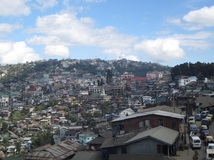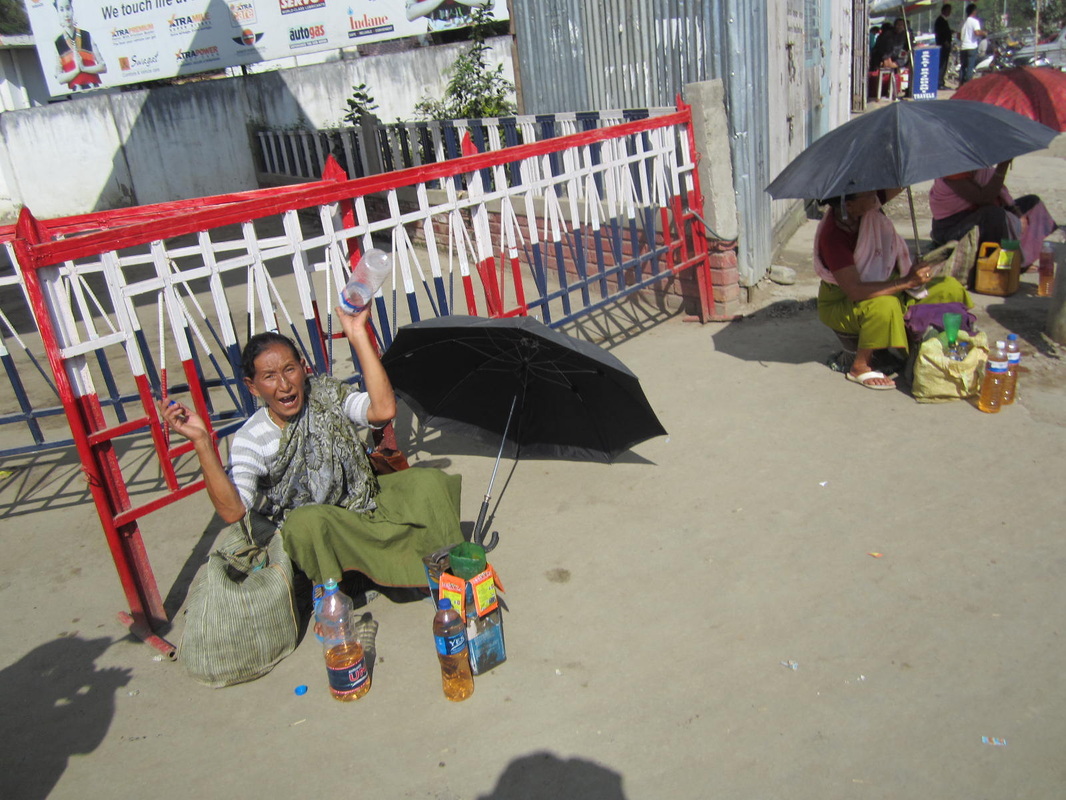
Kohima is a place I’d wanted to visit for a very long time, ever since I learnt about the epic siege that took place in the Second World War. The town is in Nagaland, on the border of Burma and due to political problems here was one of the North East States that you needed special permission to travel to, and that was only given to organized groups. In 2011 that restriction was removed and travellers could go to the area without an ‘inner line permit’ as it was called.
Groups had visited in the past to visit the Commonwealth War Cemetery which is in the center of the town and which has been laid out on the site of some of the fiercest fighting during the siege of the Kohima in April 1944; most of the rest of the battlefield has now been built over.
Kohima has expanded out onto the neighbouring hills and there is now a population of over a quarter of million. The built up area is spread over the top of the steep hills and the jungle below laps up against the houses. Looking east towards Burma, the mountainous country is still covered in thick forest. Most of the people in Kohima are Nagas, the ethnic group of tribes people that lived in villages in the surrounding jungle but who now live mainly in towns. They look very different from the few Indians who live here, being quite small, with Chinese\Burmese features and darker skins.
The ethnic difference has been a problem since the war, as although the Nagas were fairly content under British rule and helped them in the fight against the Japanese; when India gained independence, the Nagas wanted their own independence as well. This has led to a long running insurgency which continues to this day. One’s first impressions of Nagaland are that it’s an area under military occupation. The town has armed soldiers continually patrolling it, and they are in addition to the numerous police on the streets. There’s no curfew but after dark, the businesses shut up quickly and by the early evening the only people moving on the streets are groups of soldiers. There are always lots of Army Lorries on the move, and often the cars of senior officers, surrounded by jeeps full of soldiers force their way through the traffic with sirens blaring. The unit in residence at the moment are the ‘Assam Rifles’, motto “Friends of the Hill People”, who were one of the Indian Army units who defended the town against the Japanese; generations later, they’re still there.
The large scale insurgency has ended, although there is a war memorial in the centre of the town which commemorates Indian soldiers killed in recent operations. Certainly it’s quiet enough for tourists to be let in, although I had to register at the police station, ‘for my security’ but this is not a place to visit if you are nervous around firearms.
The Nagas are also very different from the few plains Indians that live in town in that they are Christians. The British suppressed Headhunting but otherwise didn’t interfere with the Naga way of life and they restricted outside access to the area and that included access by missionaries. With independence America missionaries moved in on soul saving missions and now most of the population are one brand of Baptist or another; the Nagas had always believed in one Supreme Being so making the transition wasn’t too difficult for them. There are huge number of churches in the town as well as boy and girls hostels, bible study centres, church halls and even a ‘Billy Graham’ Road. On Sundays nearly everything is shut and families walk together to church clutching their bibles, usually heavily thumbed leather bound or ‘Good News’ editions. Everyone is dressed in their Sunday best with the women and girls in some fantastic outfits. Walking around throughout the day, it’s always possible to hear hymns and inspirational songs being belted out somewhere in the town.
On Sunday the Naga shawls and waistcoats also appear, probably the only time Naga culture is on display. Apart from a few ‘ceremonial’ entrances made from corrugated iron the traditional way of building has been replaced by poured concrete, and there almost no signs of the Nagas former way of life to be seen anywhere. A ‘made for tourists’ Naga village has been constructed outside Kohima, and this has an arena where the annual Hornbill festival is held each December. Even though this has always been a traditional Naga festival, the fact that there lots of other events going on at the same time, like the Hornbill Half Marathon, the Hornbill Car Rally and weeklong series of Rock concerts (Heavy Metal is very popular in the North East), I imagine most of the population will be doing other things, and not watching traditional dancing.
Anyone going to Kohima expecting a cultural experience are going to be disappointed, the main reason to go there is to see the site of one of the great feats of courage and endurance in the history of the British Army, but that is another story. (more to follow)
Groups had visited in the past to visit the Commonwealth War Cemetery which is in the center of the town and which has been laid out on the site of some of the fiercest fighting during the siege of the Kohima in April 1944; most of the rest of the battlefield has now been built over.
Kohima has expanded out onto the neighbouring hills and there is now a population of over a quarter of million. The built up area is spread over the top of the steep hills and the jungle below laps up against the houses. Looking east towards Burma, the mountainous country is still covered in thick forest. Most of the people in Kohima are Nagas, the ethnic group of tribes people that lived in villages in the surrounding jungle but who now live mainly in towns. They look very different from the few Indians who live here, being quite small, with Chinese\Burmese features and darker skins.
The ethnic difference has been a problem since the war, as although the Nagas were fairly content under British rule and helped them in the fight against the Japanese; when India gained independence, the Nagas wanted their own independence as well. This has led to a long running insurgency which continues to this day. One’s first impressions of Nagaland are that it’s an area under military occupation. The town has armed soldiers continually patrolling it, and they are in addition to the numerous police on the streets. There’s no curfew but after dark, the businesses shut up quickly and by the early evening the only people moving on the streets are groups of soldiers. There are always lots of Army Lorries on the move, and often the cars of senior officers, surrounded by jeeps full of soldiers force their way through the traffic with sirens blaring. The unit in residence at the moment are the ‘Assam Rifles’, motto “Friends of the Hill People”, who were one of the Indian Army units who defended the town against the Japanese; generations later, they’re still there.
The large scale insurgency has ended, although there is a war memorial in the centre of the town which commemorates Indian soldiers killed in recent operations. Certainly it’s quiet enough for tourists to be let in, although I had to register at the police station, ‘for my security’ but this is not a place to visit if you are nervous around firearms.
The Nagas are also very different from the few plains Indians that live in town in that they are Christians. The British suppressed Headhunting but otherwise didn’t interfere with the Naga way of life and they restricted outside access to the area and that included access by missionaries. With independence America missionaries moved in on soul saving missions and now most of the population are one brand of Baptist or another; the Nagas had always believed in one Supreme Being so making the transition wasn’t too difficult for them. There are huge number of churches in the town as well as boy and girls hostels, bible study centres, church halls and even a ‘Billy Graham’ Road. On Sundays nearly everything is shut and families walk together to church clutching their bibles, usually heavily thumbed leather bound or ‘Good News’ editions. Everyone is dressed in their Sunday best with the women and girls in some fantastic outfits. Walking around throughout the day, it’s always possible to hear hymns and inspirational songs being belted out somewhere in the town.
On Sunday the Naga shawls and waistcoats also appear, probably the only time Naga culture is on display. Apart from a few ‘ceremonial’ entrances made from corrugated iron the traditional way of building has been replaced by poured concrete, and there almost no signs of the Nagas former way of life to be seen anywhere. A ‘made for tourists’ Naga village has been constructed outside Kohima, and this has an arena where the annual Hornbill festival is held each December. Even though this has always been a traditional Naga festival, the fact that there lots of other events going on at the same time, like the Hornbill Half Marathon, the Hornbill Car Rally and weeklong series of Rock concerts (Heavy Metal is very popular in the North East), I imagine most of the population will be doing other things, and not watching traditional dancing.
Anyone going to Kohima expecting a cultural experience are going to be disappointed, the main reason to go there is to see the site of one of the great feats of courage and endurance in the history of the British Army, but that is another story. (more to follow)


 RSS Feed
RSS Feed
